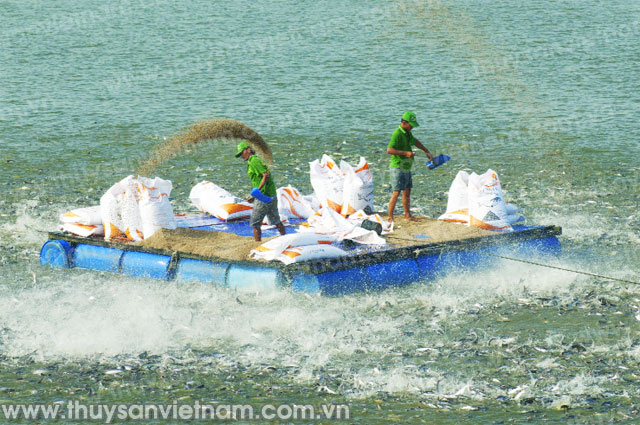To enhance added values for Tra fish products, attention should be paid not only to the processing but also right from the farming, especially the selection of fries and feeds and breeding techniques.
Why are the added values of Tra fish products not high?
Over the past years, the Tra fish sector has grown quickly with the farming area increasing more than 10 times and the output topping 1 million tons. The sector plays an important role in the economic development. With hundreds of frozen Tra fish fillet processing facilities, it attracts more than 200,000 workers, earning USD 1.8 billion from its exports in 2013.
However, the existing inadequacies in the farming have made it difficult for the Tra fish sector to raise added value for its products over the past time. Specifically, farming technologies and techniques are very simple, primarily based on experience passed down by successful farmers. Technical standards and regulations related to aquaculture conditions and the process of breeding have been issued late while the implementation is not concerted. Besides, it is difficult to raise the traceability. The quality of Tra fries is low, causing adverse effect on the farming and output of Tra fish. In the past, thanks to quality fries, it took farmers just 6-7 months to have commercial Tra fish for export (about 0.9-1.2 kg/head). Currently, due to poor quality Tra fries, farmers must spend 8-9 months. That’s why Tra fish production costs have soared over the recent past.
Environmental pollution and diseases in Tra fish caused by high stocking density (50 – 70 head/ square meter) are big problems. Farmers take full advantage of any land for the farming, resulting in contaminated water sources, a high risk of the outbreak of Tra fish diseases, and high demand for drugs and chemicals. In recent years, the complicated developments of epidemic diseases in Tra fries and commercial fish as Enteric Septicaemia, jaundice, white liver and white gill, parasitic disease, etc increased the mortality to 20-30%, causing significant damage to farmers.
Almost all farmers and processing enterprises are running their small-scale model, with a lack of close collaboration. This cause certain difficulties for farmers in selling their fish. The distribution of benefits in the production chain is irrational as farmers often suffer more losses than processors.

Tra fish farming in Mekong Delta – Photo: Le Hoang Vu
Increase added value right from the farming
It is necessary to enhance added values for Tra fish right from the phase of farming and processing. Specifically, reducing the cost price of material Tra fish is counted as a key factor. Costs for feeds, loan interest rates and fries account for over 80% of the total. Poor quality fries can lead to a mortality rate of 20-30%. Top priority should be given to managing the quality of fries and feeds while the interest rate is an important factor.
First of all, the quality of Tra fries must be improved by increasing investment in fry production facilities to ensure all fries are uninfected. Besides, the application of biotechnology is needed to have quality Tra fish with white flesh and high yield.
Secondly, it is advisable to develop material sources in the home market to reduce input materials imported by feed processing facilities, such as corn, soybeans, fish meal, etc, in order to cut down the cost price of Tra fish products. Mechanisms must be developed to control the quality and price of feed.
Regarding the farming techniques, the application of advanced and appropriate breeding techniques depends on the scale of production, infrastructure and technical expertise of each facility. For example, it is rational to apply management procedures in small farms and farming Good Aquaculture Practices and international standards in planned farming areas. The stocking density should be reduced to 30-40 fries / square meter, helping cut the feeding, while the application of interrupted feeding every five days (the feeding is paused for from one to two days per week) is needed to reduce the amount of feed. This has proved effective.
Increasing values for Tra fish exports
Cutting processing costs is not simple, especially in the context of rising input costs (material prices are pushed up to ensure that farmers make profits. Labor costs increase according to market trends while the prices of materials oil and gas, electricity and water depend on market turbulence, along with high interest rates). For businesses, the structure of costs for processing Tra fillet exports is now relatively rational. Therefore, it is difficult to cut the costs any more. The price of raw fish should be even increased to ensure farmers earn profits. Some proposals have been made to reduce the costs and increase added values, focusing on restructuring products, reducing the proportion of frozen Tra fish fillets, and increasing the proportion of deeply-processed, ready-made, and instant products by increasing investment in new production equipment and technologies.
Also, all by-products during the processing of Tra fish should be utilized to create various products, increase value for the fish and reduce the production costs of the key product (fillets), which contributes greatly to environmental protection. To do this, research on new products and investment in equipment and technologies dedicated to by-products in the processing of frozen fillets, including pieces of fish and offal, should be strengthened to create value-added products as fish surimi, refined fish oil, fish meal, salted shredded fish, bloating fried dried fish, collagen, gelatin, etc.
Last but not least, the cost of processing can be lowered through the application of cleaner technologies in the production to save electricity, water and materials, as well as the model of production chain from farming, processing and selling Tra fish products.